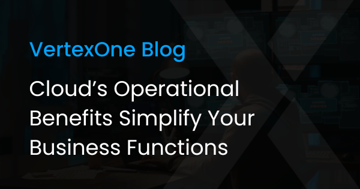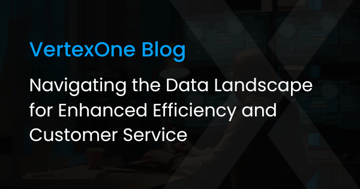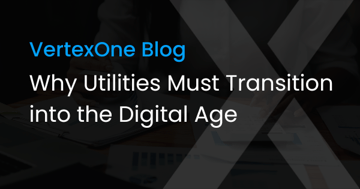This article was originally published on www.cloudforutilties.org and can be viewed here
Should you own or lease your information systems and architecture? It’s a debate that utilities have had for years now, and one we’ve discussed a bit, too. Vertex did some research on the pros and cons of both, just to see what’s changed. Interestingly, most of the information was old in technology-growth terms and, in many cases, out-of-date.
Much of the nomenclature used has changed or no longer conveys a crystal-clear message. Even the familiar analogies used to explain the difference between an on-premise and hosted or “cloud” solution no longer mesh completely with current cloud computing models.
In the utility industry, the role of the customer information system (or CIS) has expanded dramatically. What was once the realm of call-centers and lobby-locked customer service reps (CSR) has now moved into the online world, and in many cases, customer self-service. The cloud-based CIS model has enabled that change, of course, but more importantly, the cloud model itself has changed.
In a moment, we’ll look at why addressing these changes effectively requires more than just a CIS that’s SaaS or cloud-based but a business integrated SaaS CIS solution. But first, let’s revisit some of the old analogies to discover where they fall down.
Buy, rent, or lease
Automobiles, apartments, office space—these familiar everyday expenses have always been used to explain the difference between owned (on-premise) and leased (or “cloud”) computing infrastructure. For a long while, they’ve been valid comparisons. However, the landscape has changed, and things aren’t quite as left or right as all that.
Analogies that compare car leasing vs. car ownership have one fatal flaw when used to compare on-premise data center solutions with their cloud counterparts. They do not adequately consider two necessary components in today’s business landscape: agility and scalability. After all, simply buying a new car or trading in your lease for a faster one isn’t quite the same as building a new data center or moving your existing infrastructure to the cloud (or to a new cloud provider). And often the major hurdles to business growth in the information age are the constraints imposed by hardware and software.
Many utility companies still struggle to maintain outdated, aging infrastructures, and are unable to keep up with current software requirements. Upgrading equipment or building a new data center can be cost prohibitive and time-consuming. And assuming you elect to do so, it’s possible your computing needs may have changed before ground is broken on a new location.
Instead, many businesses opt to move to the cloud, where changes can be made rapidly and seamlessly. According to an April 2018 Gartner® report, The Data Center is Dead, and Digital Infrastructure Emerge, 80% of enterprises intend to shut down their traditional data centers. And that doesn’t include the 10% that have already done so.
Indeed, businesses must embrace some form of cloud computing, whether it is public, a private on-premise cloud, a private cloud fully hosted in a partner’s data center, or some mixture of these. According to David W. Cearley, VP and Gartner Fellow at Gartner Research:
Organizations that do not have a high-level cloud strategy driven by their business strategy will significantly increase their risk of failure and wasted investment.
While the cloud, in its many forms, addresses infrastructure scalability, utilities also scramble to keep up with consumer demand for innovative new self-service and other online features. Rather than trying to develop and enhance applications themselves, many have already turned to SaaS solutions. These solutions, usually hosted in the cloud, offer access to continuous updates, including patches and feature enhancements, without the need for major projects associated with on-premise software upgrades.
Mitigating common concerns about cloud-based solutions
However, there are still businesses that hesitate to consider these options, usually due to concerns about putting their business in the hands of others.
If you lease your cloud, will your data remain secure? That’s a top question many CIOs ask, and they are right to be asking it. After all, once your data is in the hands of someone else, how can you be sure it’s safe?
The truth is that most hosting companies and cloud providers have more and better-trained resources to watch over your “valuables” than you do. Many even employ ethical hackers to work on discovering vulnerabilities, so they can patch them before the bad guys can find and exploit them.
“In terms of the advantage, a cloud-based offering is going to be up-to-date. In general, the security will be top of the line.” – Richelle Elberg, Principal Research Analyst, Navigant
Another concern with SaaS providers is whether you actually own the software and data your company generates. With many SaaS companies, if you decide to part ways, you’ve got nothing—except an export of all your data (if your contract allows you to get one).
You should make sure your contract spells out your ownership rights to the software running your solution. That way, should you choose, you can take possession and run your software on your own hardware—or even move it to another hosting company. And if the SaaS provider’s solution is built on an established ERP base such as SAP, make sure any upgrades or specialized configurations remain in your control as well.
With VertexOne’s solution, companies always own their data and specific CIS configurations, as well as the licenses for the underlying software.
Finally, does it make financial sense to migrate to a business-integrated SaaS CIS model? The short answer is yes, more than ever.
For one, the hosting company handles maintenance for the major computing hardware as part of your contract, so you won’t incur the sudden costs of unexpected hardware failures. Plus, their solutions often have redundancy and backups built in to avoid costly downtime. And should your demand increase over time—as a growing company should—a business-integrated SaaS solution can scale to meet the demand, with only an incremental OpEx expense, instead of a major capital expenditure.
From the accountant’s standpoint, cloud computing is becoming more attractive as time progresses. Moving to the cloud always represented a shift from capital expenses (CapEx) to operation expenses (OpEx). However, for utilities—whose rate cases rely on capitalization—this fatal flaw made the move to the cloud even more difficult. Thankfully, accounting for cloud-based systems is changing, and many of the costs—including the implementation project and software licenses—can be capitalized directly. As for the ongoing costs, work with the hosting and SaaS providers to structure an agreement to properly classify all expenses, yet allows you to maximize your capitalizable costs.
The digital landscape is changing, and a business integrated SaaS CIS solution makes good business sense for all involved.





